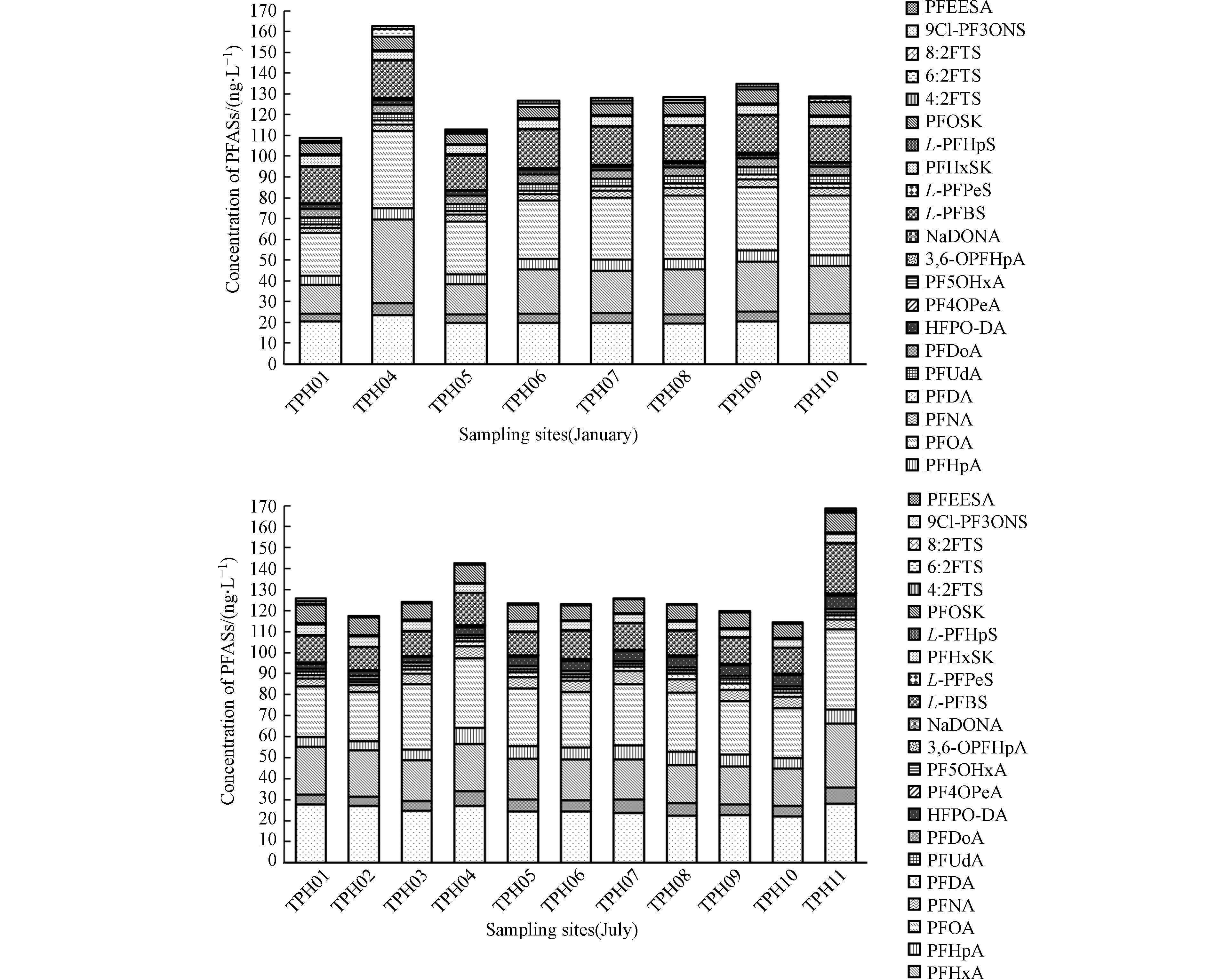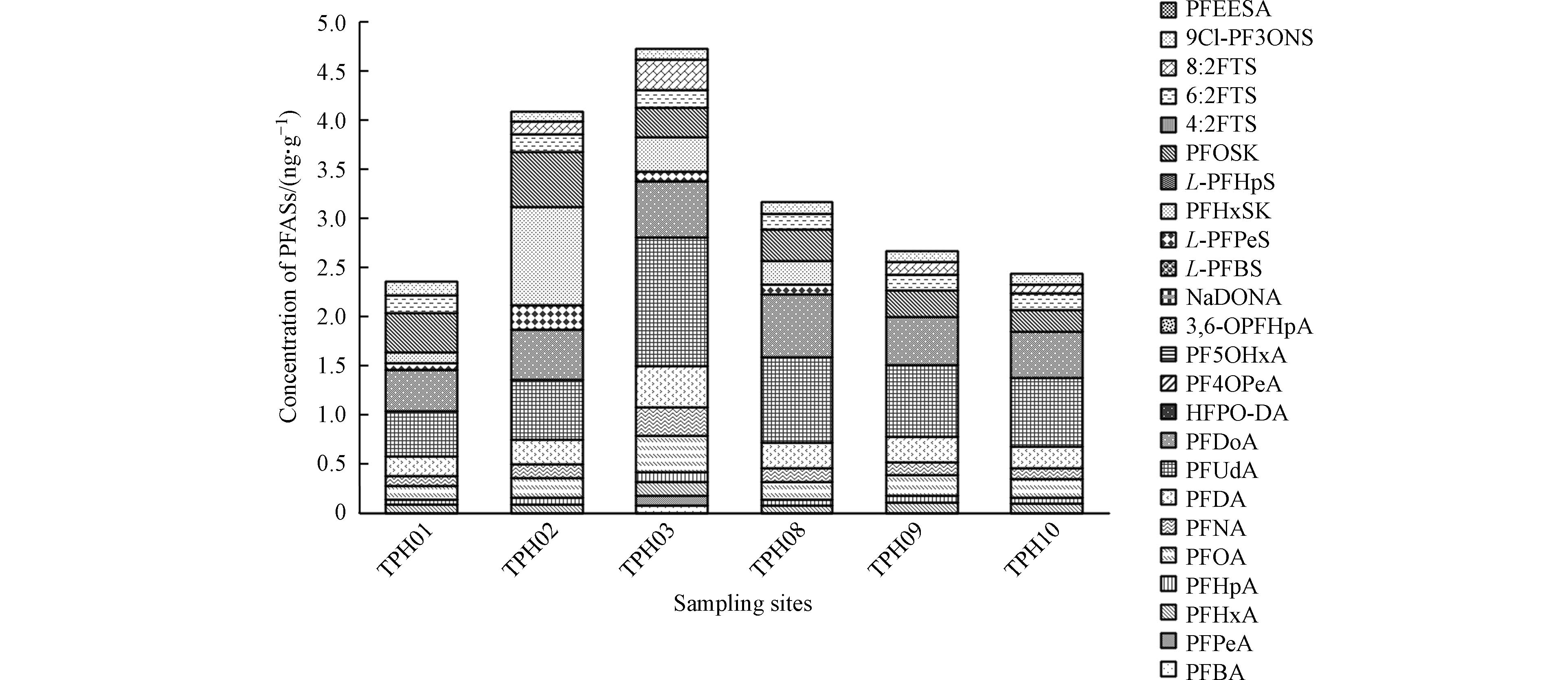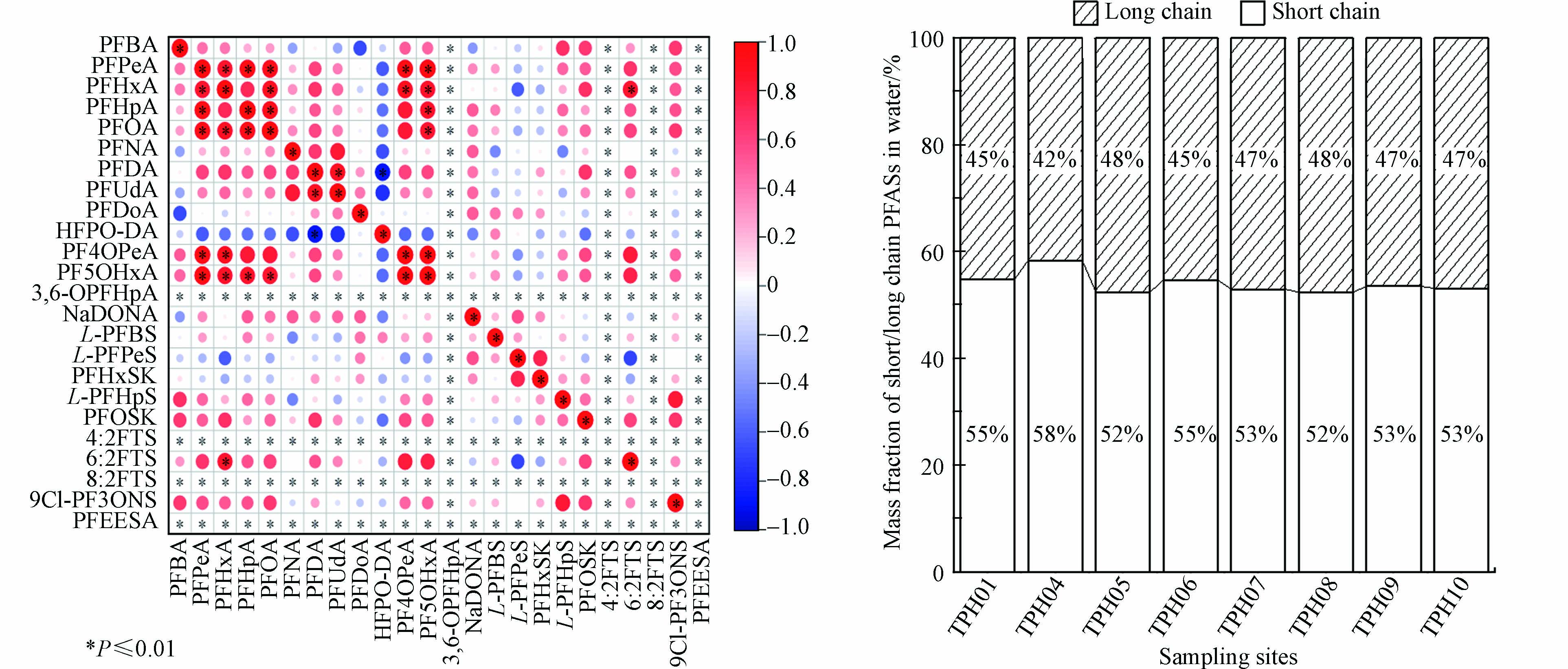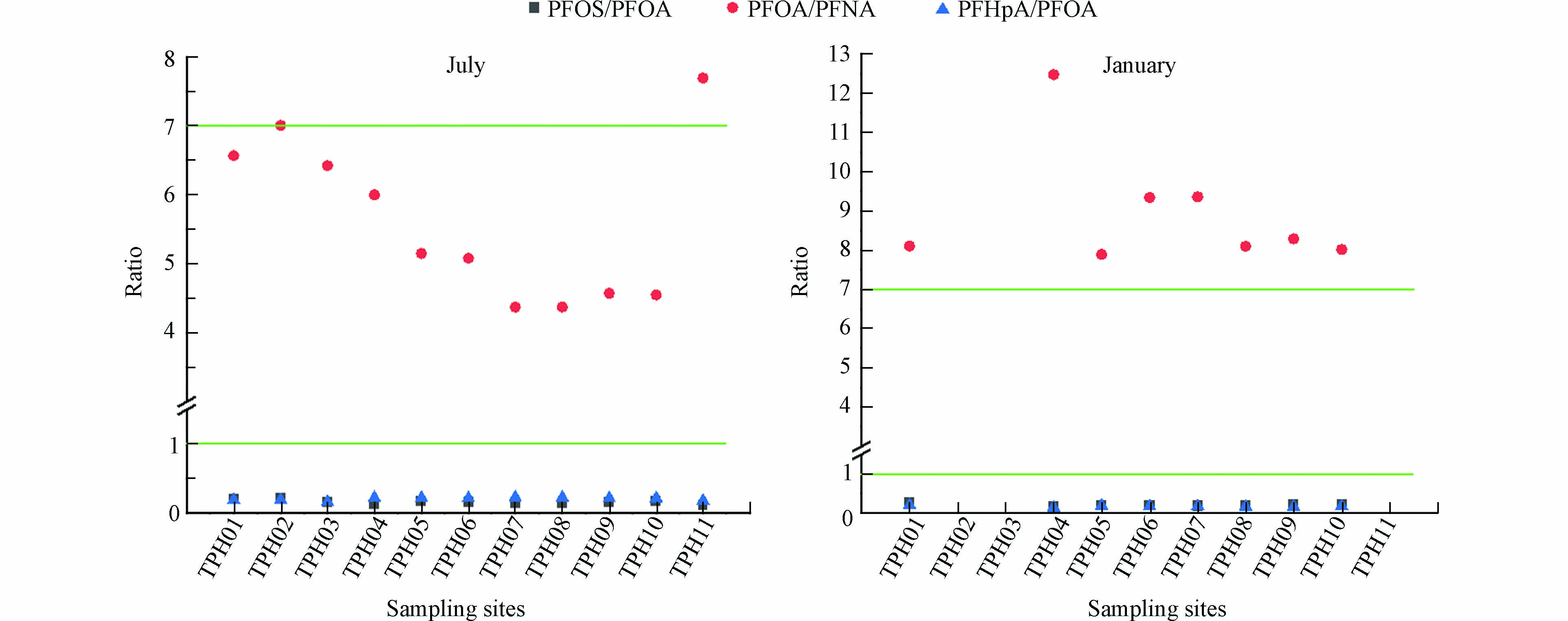-
全氟化合物(polyfluoroalkyl substances,PFASs)具有良好的疏水疏油性、高活性和热稳定性,被广泛应用于工业生产和民用成品制备[1]. 随着含氟产品的生产、使用和处理,PFASs被释放到周围的环境中. 同时,该物质具有环境持久性、远距离迁移性和生物蓄积性,使得其最终进入到整个生态系统中,作为一类持久性有机污染物对周围的生态环境和生物物种造成潜在风险[2-6]. 尽管国内外已经对传统的PFASs做出管控[7-8],但鉴于该类物质在生产过程中不可或缺,使得近些年氟化工生产商研制出更多的含氟替代品,用结构类似的以及短链的PFASs[9]代替传统PFASs来满足市场需求. 目前,已有研究表明,这类替代品同样具有环境持久性以及生物毒性,且在环境中已被大量检出[10].
工业生产排放是PFASs最主要的来源,目前,关于PFASs进入环境有两种猜想:一种是半挥发性、挥发性PFASs随大气运动远距离传输[11],另一种是水体环流带动离子态PFASs迁移[12]. 河流承载了来自工业生产过程中产生的PFASs,最终进入海洋中[13]. 所以,了解水环境中PFASs在水体与沉积物的分配机制对理解PFASs在环境中的迁移转化规律具有重要意义.
太浦河是连接东太湖和黄浦江的重要河段,是上海市重要的饮用水水源地之一,为上海市西南5区提供原水. 目前,太浦河的水质调查多围绕抗生素[14]、重金属[15]等展开,而对于PFASs在太浦河中的时空分布特征以及在沉积物和水中分配规律的了解非常有限. 大量研究表明,PFASs的碳链长度会影响沉积物的吸附量[16-17],沉积物本身的理化性质,如总有机碳(total organic carbon,TOC)[18-20]也会影响到水环境中PFASs的分配规律. 因此,研究PFASs链长以及太浦河中沉积物的TOC含量对PFASs在水环境中分布特征的影响,可以揭示PFASs在河流中的迁移转化规律.
本研究以传统、替代和短链的24种PFASs为研究对象,针对太浦河流域的水体和沉积物,于冬、夏两季采样并分析该河段重要点位的水体和沉积物样品中目标PFASs的污染水平和分布规律,研究该流域目标PFASs季节性变化规律,解析PFASs在太浦河不同介质中的归趋、分布特征和来源,不仅为饮用水安全风险评估提供数据,还可为控制PFASs的排放提供科学依据.
-
主要仪器包括:高效液相色谱-串联质谱(Waters公司,美国),全自动氮吹仪(睿科仪器股份有限公司,厦门),超声波清洗器(安谱实验科技股份有限公司,上海),全自动固相萃取仪(睿科仪器股份有限公司,厦门),低温真空冷冻干燥机(昊博低温真空设备有限公司,上海),总有机碳分析仪(耶拿分析仪器股份公司,德国),电子分析天平(岛津实验器材有限公司,上海).
实验过程中使用的甲醇、乙腈(色谱纯)购于德国Merck公司,乙酸铵(色谱纯)购于美国ANPEL公司,氨水(>25%)购于上海易恩化学技术有限公司. 标准品(>98%)均购于加拿大惠灵顿公司,具体信息如表1所示.
-
本研究于2022年1、7月期间采集了太浦河流域的19份水样与6份沉积物样品,具体采样点和采集情况如图1和表2所示. 使用不锈钢采水器采集水面以下0.5—1 m处的水样,装入1 L高密度聚乙烯容器中. 使用不锈钢抓斗式采泥器采集采水处附近1 m2范围内的沉积物样品,并装入不锈钢容器中. 对于入河口、航运发达和工业繁华的点位(TPH1、TPH3、TPH4、TPH11),收集两个平行样,混合均匀后进行前处理,以减少采样过程中的随机性. 水样采集后在24 h内完成预处理,沉积物样品冻干并过100目筛(0.15 mm)后,装入聚丙烯袋中于−20 ℃保存,待进一步处理.
-
水样前处理在刘晓雷等[21]方法上进行了优化,具体过程为:取250 mL水样,过0.7 μm的GF/F玻璃纤维滤膜(Whatman公司,英国),加入5 ng内标后混匀待用. 依次用5 mL 0.1%的氨水/甲醇(V:V)溶液以及5 mL超纯水(Milli-Q)活化Oasis-WAX固相萃取柱(500 mg,6 mL),将水样以3 mL·min−1的流速通过预活化的WAX小柱富集目标PFASs. 用5 mL 25 mmol的乙酸铵水溶液和5 mL 80%甲醇/水溶液淋洗小柱,气推除去残余水分. 最后,用10 mL 0.1%的氨水/甲醇溶液和5 mL 0.1%的氨水/乙腈溶液洗脱,气推并收集洗脱液. 洗脱液在水浴加热45 ℃条件下氮吹至近干,用500 μL的2 mmol·L−1乙酸铵水溶液:甲醇(30:70,V:V)的溶剂复溶,通过0.22 μm PTFE针式滤器转移至聚丙烯进样小瓶中.
沉积物前处理在Shi等[22]的方法上进行改进:称取1 g冻干后的沉积物样品,加入5 ng内标和5 mL的甲醇溶剂. 涡旋混匀2 min,在30 ℃下超声20 min,最后3000 r·min-1离心10 min后,抽取上清液过0.45 μm的玻璃纤维针式滤器至另一个50 mL离心管中. 重复上述提取步骤两次,将提取的上清液合并后氮吹至近干,复溶后将溶液转移至进样小瓶.
-
24种PFASs的分析仪器为Waters Acquity HPLC@I Class液相色谱仪串联Waters Xevo TQ-XS micro质谱仪,色谱柱为ACQUITY UPLC®BEH C18(ϕ2.1 mm
$ \times $ 100 mm,1.7 μm,美国Waters公司). 流动相A为5 mmol的乙酸铵水溶液,流动相B为乙腈,采用梯度洗脱的方式:0—3.5 min,10%—50% B;3.5—6.0 min,50%—95% B;6—8 min,95% B;8—8.5 min,95%—10% B;8.5—10 min,10% B. 进样量为1 μL,流速为0.3 mL·min−1,色谱柱柱温为40 ℃.质谱条件为:采用多重反应离子监测模式(MRM),电喷雾负离子扫描模式(ESI-),离子源温度150 ℃,脱溶剂气温度500 ℃,脱溶剂气流速1000 L·h−1,毛细管电压3 kV,氮气作为脱溶剂气和锥孔气,氩气作为碰撞气.
-
本研究实验过程中使用的器皿均为聚丙烯材料,使用前用纯水和甲醇润洗并晾干,全自动固相萃取仪使用结束后,用纯水和甲醇对管路进行二次冲洗,每次实验均设置空白对照以及溶剂空白,每个点位的样品设置3个平行,尽可能减少环境因素对实验结果的影响. 对24种PFASs在0.14—50 ng·mL−1的浓度区间内配制7个浓度梯度的标曲,加入10 ng·mL−1的内标. 24种PFASs在此浓度区间内具有良好的线性关系(R2>0.995). 分别向7个空白样中加入一定量的标准品(250 mL水样中加0.25 ng和1 ng标准品,1 g沉积物样品中加0.5 ng和1 ng标准品),根据7次平行的标准偏差计算方法检出限(MDL),计算公式为:MDL=t(n-1,α=0.01)×S, t分布;n为样品自由度;S为加标样品减去空白样品的标准偏差. 向3个空白样品中分别加入高、中、低浓度(水样:4、20、50 ng·L−1;沉积物:1、5、10 ng·g−1)的混标,得到水和沉积物的加标回收率. 水体中PFASs的回收率在71.67%—105.33%,相对标准偏差均小于20%;沉积物中PFASs的回收率在60.17%—149.43%,相对标准偏差均小于20%,PFASs在水体和沉积物介质中的MDL分别在0.104—1.006 ng·L−1和0.050—0.131 ng·g−1,均满足痕量分析的要求.
-
数据处理使用Excel 2016和Origin 2016软件. 统计时,若PFASs含量<MDL,数值以0计算. 选取同一点位的水样和沉积物中PFASs的含量来计算分配系数,计算公式[23]为:
式中,
$ {K}_{\mathrm{d}} $ —PFASs的水-沉积物的分配系数,L·kg−1;$ {C}_{\mathrm{s}} $ —沉积物中PFASs的含量,μg·kg−1;$ {C}_{\mathrm{w}} $ —水体中PFASs的含量,μg·L−1;$ {K}_{\mathrm{o}\mathrm{c}} $ —PFASs经有机碳校正后的水-沉积物的分配系数,L·kg−1;$ {f}_{\mathrm{o}\mathrm{c}} $ —沉积物中TOC的质量分数. -
本研究分别在2022年1月份与7月份采集太浦河表层河水并检测,冬、夏季水体中24种目标PFASs的浓度水平对比和各点位的PFASs含量见图2和图3. 结果表明,冬季太浦河水体中共检出了20种PFASs,除3,6-OPFHpA、4:2FTS、8:2FTS和PFEESA未检出外,其他目标PFASs检出率在37.5%—100%,说明目标PFASs在太浦河水体中普遍存在.
$ \mathrm{\Sigma } $ PFASs浓度范围在108.67—162.59 ng·L−1,其中PFHxA和PFOA的检出浓度较大,平均浓度为22.44 ng·L−1和28.86 ng·L−1,略大于金磊[24]在太浦河流域的调查结果(PFHxA和PFOA的平均浓度为18.25 ng·L−1和24.81 ng·L−1),中位数浓度为21.56 ng·L−1和29.26 ng·L−1. 24种目标PFASs中,PFCAs和PFSAs的检出率为100%,其他种类的目标PFASs检出率较小且浓度水平低.夏季太浦河水体中共检出了21种PFASs,除3,6-OPFHpA、4:2FTS和PFEESA未检出外,其他目标PFASs检出率在18.18%—100%.
$ \mathrm{\Sigma } $ PFASs浓度范围在114.24—168.62 ng·L−1,其中PFBA和PFOA的检出浓度较大,平均浓度为24.92 ng·L−1和28.18 ng·L−1,中位数浓度为24.36 ng·L−1和27.30 ng·L−1. 由图2可以看出,冬、夏两季各点位水体中PFASs浓度与种类差异较小,没有表现出明显的季节性变化. 研究表明,湿沉降是影响河流中PFASs浓度的一个重要因素[25-27],工业生产未能处理的PFASs随着降水和地表径流进入周围的水体,会出现湿季(夏季)水体中PFASs含量、种类高于干季(冬季)的现象. 通过查询中国气象局资料发现,太浦河流域2022年1月份的月累积降水量为50—100 mm,与2022年7月份的数据相同,没有表现出季节性变化特征. 此外,太浦河附近污染源排放较为稳定. 故此次监测结果没有体现出明显差异.由图3可以看出,太浦河各点位水体中
$ \mathrm{\Sigma } $ PFASs波动不大,冬季在128 ng·L−1左右,夏季在125 ng·L−1左右,总体低于东太湖水体中$ \mathrm{\Sigma } $ PFASs的含量(176 ng·L−1左右)[28]. 这与太湖流域汇集了来自江苏境内氟化工厂和纺织工业产生的PFASs,而太浦河附近大型的氟化工厂少有关. 在京杭大运河附近的TPH4和南横港附近的TPH11,水体中PFASs的总浓度明显高于其他地点的水样. 这两个点位所在河段都是重要的航道,航运活动频繁,船只与码头的防水油脂和保护油漆中的含氟物质会使附近水体中PFASs突增[29]. -
沉积物是持久性有机污染物的一个重要归趋[30],本研究沿太浦河采集了6个点位的沉积物并检测其PFASs的含量. 除HFPO-DA、PF4OPeA、PF5OHxA、3,6-OPFHpA、NaDONA、L-PFBS、L-PFHpS、4:2FTS和PFEESA外,15种目标PFASs在太浦河沉积物中都有不同程度的检出,检出率在16.67%—100%,
$ \mathrm{\Sigma } $ PFASs在2.36—4.73 ng·g−1(dw),小于太湖流域沉积物中$ \mathrm{\Sigma } $ PFASs的含量(5.8—35 ng·g−1(dw))[28]. PFUdA和PFDoA检出浓度最大,平均浓度为0.78 ng·g−1(dw)和0.52 ng·g−1(dw),中位数浓度为0.72 ng·L−1(dw)和0.50 ng·L−1(dw).从各点位沉积物中目标PFASs的含量变化(图4)可以看出,TPH2和TPH3沉积物中PFASs的含量较高,其它点位沉积物中PFASs含量则较少. 调查发现,TPH2和TPH3点位沿岸的纺织业和造纸业发达,而PFASs在纺织、造纸等领域有着广泛的应用[31-32],随着其生产、使用和处置过程,将会有大量的PFASs进入周围的水环境中,并使得该点位附近沉积物中PFASs含量增大.
-
太浦河上游与东太湖相连接,其中PFOA是太湖中最主要的PFASs[28],本次研究结果也表明太浦河水体中PFOA浓度最高. 从图5可以看出,除PFOA外,太浦河表层水体中碳链长度<7的PFASs含量和检出率明显高于长链PFASs,短链的PFHxA、PFBA和L-PFBS是水中主要的PFASs,占比为46.45%,这可能是短链的PFASs相较于长链PFASs具有更大的溶解度[33]和更高的迁移率. 水体中检测到浓度最高的PFSAs是PFBS,PFOS对PFASs的贡献率显著下降,说明《斯德哥尔摩公约》的限制[34]对控制PFOS的生产排放取得了较好的效果. 而现有的法规也加强了对长链PFASs的监管,新型的短链PFASs(PFHxA、PFBA和L-PFBS)逐渐代替了传统的长链PFASs(PFOA和PFOS),并在水环境中被大量检测到[35].
长链PFASs在沉积物中浓度最大,沉积物中长链(依据经济合作与发展组织的准确定义:
$ \ge $ 6个碳原子的PFSAs,以及$ \ge $ 7个碳原子的其它PFASs)的PFASs对$ \mathrm{\Sigma } $ PFASs的贡献率是短链PFASs的7.76倍,与之前报道的长链PFASs较短链PFASs更易吸附在沉积物上一致[36]. 这可能与长链PFASs化学性质更稳定[37],且水溶性弱有关[38]. 在相同碳链长度情况下,不同官能团的PFASs在沉积物和水体中分配情况也不相同:沉积物中同碳链长度的PFSAs浓度普遍大于PFCAs,与水体中的情况相反,这与Lau等[38]研究结果一致,说明PFSAs比PFCAs更易附着在沉积物上.影响PFASs在水环境中分配的因素除了碳链长度外[16],还包括了沉积物中
$ {f}_{\mathrm{o}\mathrm{c}} $ [39]、水的硬度和pH值[16]. 其中分配作用中起主导作用的是沉积物的有机质与脂肪,它们可作为有机溶剂将水相中溶解度较小的PFASs萃取到沉积物中,并随着时间推移达到平衡[40]. 本研究选取不同碳链长度的PFCAs和PFSAs,研究它们在沉积物和水体间的分配系数lgKd和lgKoc. 从图6可以看出,PFHxA、PFHpA和PFOA的lgKd在0.57—1.29,变化趋势较小,但从PFOA开始到PFUdA,lgKd随着碳链长度的增加而呈明显的增长趋势,这与杨洪法等[41]和Wang等[42]研究结果一致. 与杨洪法等[41]研究得到的PFSAs的lgKd随碳链长度增加而增加不同,3种PFSAs的lgKd随碳链长度变化趋势不明显,这可能是与沉积物中短链PFSAs的检出率(67%)低于长链PFSAs的检出率(100%)有关. 经$ {f}_{\mathrm{o}\mathrm{c}} $ 校正后, 不同PFASs的lgKoc变化趋势见图6. 其变化趋势与lgKd完全一致,除沉积物中存在点位未检出的L-PFPeS和PFHxSK外,各PFCAs和PFSAs的lgKoc均比lgKd高1.69个对数单位. 这表明,在水环境体系中,$ {f}_{\mathrm{o}\mathrm{c}} $ 是影响PFASs在水体和沉积物中分配情况的重要因素[23]. 除去未检出的情况,相同碳链长度PFCAs的lgKoc值均低于PFSAs:PFHxA比PFHxSK的lgKoc值低1个单位左右,PFOA比 PFOSK的lgKoc值低0.8个单位左右,说明PFSAs较PFCAs更易吸附在沉积物上. -
太浦河周围水系发达,航运和渔业在发展过程中产生的PFASs将会直接排入周围的水体,除此之外,半挥发态、挥发态的前体物随大气运动以及离子态的PFASs随水流进行远距离输送[11-12],都可能是太浦河水环境中PFASs的重要来源. 目前推断水环境中PFASs潜在来源常用的方法是各PFASs间的相关性分析[43],本研究选用1月份水样监测数据进行分析,水体中各PFASs间Spearman相关分析和短/长链的质量分数见图7(a)和图7(b). PFOS与PFHxA呈显著性相关(P<0.01),这与肖少可等研究结论一致[44]. 由图7(a)可知,PFPeA与PFOA、PFHpA、PFHxA、PF4OPeA和PF5OHxA呈显著性正相关(P<0.01),PFHxA与PFOA、6:2FTS、PF4OPeA和PF5OHxA呈显著性正相关(P<0.01),PFHpA与PF5OHxA和PFOA呈显著性正相关(P<0.01),PFOA与PF5OHxA呈显著性正相关(P<0.01),PFUdA与PFDA呈显著性正相关(P<0.01),PF4OPeA与PF5OHxA呈显著性正相关(P<0.01),说明它们可能具有相同的来源. 还可根据河流方向,不同点位间短/长链的比值,来判断外源输入(短链多)和点源排放(长链多)对水体中PFASs的贡献率[45]. 根据图7(b)可以看出,太浦河水体中短链PFASs与长链PFASs占比相近,且各点变化趋势不大,说明该地区水体中PFASs的来源包括了外源输入和点源排放,且两个来源的贡献值相当.
比值法是研究PFASs来源的另一个重要方法,通过分析水样的PFOS/PFOA、PFOA/PFNA和PFHpA/PFOA值来追溯源头. PFOS/PFOA值常用于探讨PFASs的潜在来源,PFOS/PFOA>1说明是PFOS的点源污染,PFOS/PFOA<1则表明是降雨输入[46]. 由图8可知,冬、夏两季各点位PFOS/PFOA值均<1,这与太湖和珠江三角洲地区的研究情况是一致的[47-48],说明降雨对太浦河流域PFASs浓度变化的影响较大[46]. 可以根据PFOA/PFNA值来判断PFASs是否来自于大气运输(PFOA/PFNA<7),工厂直排(7<PFOA/PFNA<15)还是前体物降解(PFOA/PFNA>15)[49]. 本研究中PFOA/PFNA值随着季节变化存在很大差异,夏季河体内PFASs主要受到大气远距离传输影响,冬季则与河道周围的工业活动有关. 各点位在不同季节的PFHpA/PFOA值均<1,同样说明了太浦河水体中的PFASs与周围工业活动和降雨输入有关[49]. 建议对太浦河中PFASs的污染进行控制,通过加强生产过程和产业排污规范化管理,以减少点源污染.
-
(1)太浦河流域11个点位水体中目标PFASs普遍检出,
$ \mathrm{\Sigma } $ PFASs在114.24—168.62 ng·L−1. 其中PFBA和PFOA的检出浓度较大,平均浓度为24.92 ng·L−1和28.18 ng·L−1. 太浦河各点位水体中$ \mathrm{\Sigma } $ PFASs的波动不大,仅在水运发达的点位出现PFASs突增的情况,且该流域PFASs季节性规律并不明显.(2)太浦河流域沉积物中目标PFASs检出的种类较少,检出率和检出浓度较低. 有15种PFASs被检出,
$ \mathrm{\Sigma } $ PFASs在2.36—4.73 ng·g−1(dw). PFUdA和PFDoA检出浓度最大,平均浓度为0.78 ng·g−1(dw)和0.52 ng·g−1(dw). 沉积物中PFASs的含量与周围工业发展有关.(3)碳链长度、PFASs官能团结构和
$ {f}_{\mathrm{o}\mathrm{c}} $ 是影响PFASs在水-沉积物分配的重要因素. 长链PFASs较短链PFASs更易吸附在沉积物中,PFCAs的lgKd和lgKoc随着碳链长度的增加而呈明显的增长趋势,在相同碳链长度情况下,PFSAs较PFCAs在沉积物中分配系数更大.(4)对水体中各PFASs间Spearman相关分析得出,多种PFASs间呈显著性正相关,它们可能具有相同的来源. 不同点位间短/长链PFASs的比值相近,说明该地区水体的PFASs的来源包括了外源输入和点源排放,且两个来源的贡献值相当. 通过PFOS/PFOA、PFOA/PFNA和PFHpA/PFOA值分析发现,降雨与工业活动是造成太浦河流域PFASs污染的主要因素,夏季河体内PFASs主要受到大气远距离传输的影响,冬季则与河道周围的工业活动有关.
太浦河水体和沉积物中24种全氟化合物分布特征
Distribution characteristics of 24 perfluorocarbons in Taipu River and sediments
-
摘要: 本研究以24种全氟化合物(polyfluoroalkyl substances,PFASs)为研究对象,于冬、夏两季采集了太浦河流域重要点位的水样以及沉积物,并采用固相萃取、液液萃取联合高效液相色谱-串联质谱(HPLC/MS-MS)的方法,探讨PFASs在太浦河流域水环境中的时空分布特征以及分配行为. 结果显示,水体中PFASs的总质量浓度范围在114.24—168.62 ng·L−1,主要的污染物为全氟丁酸(PFBA)和全氟辛酸(PFOA),平均浓度为24.92 ng·L−1和28.18 ng·L−1;沉积物中
$ \mathrm{\Sigma } $ PFASs在2.36—4.73 ng·g−1(dw,干重),主要的污染物为全氟十一酸(PFUdA)和全氟十二酸(PFDoA),平均浓度为0.78 ng·g−1(dw)和0.52 ng·g−1(dw). 水样的监测结果显示,各点位PFASs总浓度波动不大,仅在个别点位出现PFASs突增的情况. PFASs在太浦河流段没有明显的季节性差异,这与今年夏季降雨量少的情况有关. PFASs在沉积物-水的分配行为表明,PFASs在沉积物-水的分配系数与总有机碳(total organic carbon,TOC)的含量、PFASs碳链长度以及PFASs官能团结构有关. 短链PFASs主要存在于水体中,长链PFASs则主要分布在沉积物中;全氟磺酸类(PFSAs)较全氟羧酸类(PFCAs)更易吸附在沉积物中. 对PFASs来源解析发现:水体中PFASs的来源包括了外源输入和点源排放,夏季河体内PFASs主要受到大气远距离传输影响,冬季则与河道周围的工业活动有关.Abstract: In this study, the spatial and temporal distribution characteristics and distribution behavior of 24 kinds of perfluoroalkyl substances (PFASs) in the water environment of the Taipu River Basin were explored. Water samples and sediments from important points in the Taipu River Basin were collected in winter and summer. Solid-phase extraction, liquid-liquid extraction and high-performance liquid chromatography tandem mass spectrometry (HPLC/MS-MS) were employed to analyzed the target compounds. The results showed that the total mass concentration of PFASs in water ranged from 114.24 ng·L−1 to 168.62 ng·L−1. The dominant pollutants were perfluorobutyric acid (PFBA) and perfluorooctanoic acid (PFOA), with average concentrations of 24.92 ng·L−1 and 28.18 ng·L−1 ; In the sediment, PFASs ranged from 2.36 ng·g−1 (dw) to 4.73 ng·g−1 (dw). The dominant pollutants were perfluorodecanoic acid (PFUdA) and perfluoro dodecanoic acid (PFDoA), with average concentrations of 0.78 ng·g−1 (dw) and 0.52 ng·g−1 (dw). The results of water samples showed that the total concentration of PFASs does not fluctuate much among most points, only a sudden increase occurred at individual points. There was no obvious seasonal difference in PFASs in the Taipu River section, which is related to the low rainfall in this summer. The distribution behavior of PFASs in sediment water showed that the distribution coefficient of PFASs in sediment water is related to the content of total organic carbon (TOC) of the sediment, the carbon chain length of PFASs and the functional group structure of PFASs. Short chain PFASs mainly exists in water, while long chain PFASs mainly in sediments; Compared to perfluorocarboxylic acids (PFCAs), perfluorosulfonic acids (PFSAs) are more easily adsorbed to sediments. The analysis of the source of PFASs shows that the source of PFASs in the water body includes external input and point source discharge. In summer, PFASs in the river is mainly affected by long-distance atmospheric transmission, and in winter, it is related to industrial activities around the river. -

-
表 1 实验所用标准品
Table 1. Standards used in the experiment
分类
Classification化合物
Compounds缩写
Abbreviation内部标准品
Internal standards碳链长度
Carbon chain length全 氟 羧 酸 类(PFCAs) 全氟丁酸 PFBA MPFBA 4 全氟戊酸 PFPeA M5PFPeA 5 全氟己酸 PFHxA M5PFHxA 6 全氟庚酸 PFHpA M4PFHpA 7 全氟辛酸 PFOA M8PFOA 8 全氟壬酸 PFNA M9PFNA 9 全氟癸酸 PFDA M6PFDA 10 全氟十一酸 PFUdA M7PFUdA 11 全氟十二酸 PFDoA MPFDoA 12 全氟及多氟聚醚羧酸类(PFECAs) 六氟环氧丙烷二聚酸 HFPO-DA M5PFHxA 5 全氟-4-恶戊二酸 PF4OPeA M8PFOA 4 全氟-5-氧代己酸 PF5OHxA M5PFHxA 5 全氟-3,6-二噁庚酸 3,6-OPFHpA M5PFHxA 5 4,8-二氧-3H-全氟辛酸钠 NaDONA M8PFOA 7 全氟磺酸类(PFSAs) 全氟丁烷磺酸盐 L-PFBS M3PFBS 4 全氟-1-戊烷磺酸钠 L-PFPeS M8PFOS 5 全氟己烷磺酸钾 PFHxSK M3PFHxS 6 全氟-1-庚烷磺酸钾 L-PFHpS M8PFOA 7 全氟辛烷磺酸钾 PFOSK M8PFOS 8 氟调聚醇类(PFOH) 氟调聚物磺酸盐 4:2 4:2FTS M8PFOS 6 氟调聚物磺酸盐 6:2 6:2FTS M8PFOS 8 氟调聚物磺酸盐 8:2 8:2FTS M8PFOS 10 全氟及多氟聚醚磺酸类(PFESAs) 9-氯十六氟-3-氧杂环己酮-1-磺酸钾 9Cl-PF3ONS M9PFNA 8 全氟烷基醚磺酸盐 PFEESA M6PFDA 4 表 2 太浦河1、7月份采样情况
Table 2. Sampling of Taipu River in January and July
采样时间
Sampling time水样
Water sample沉积物
Sediment1月January TPH1、TPH4—TPH10 — 7月July TPH1—TPH11 TPH1—TPH3、TPH8—TPH10 -
[1] GIESY J P, KANNAN K. Global distribution of perfluorooctane sulfonate in wildlife [J]. Environmental Science & Technology, 2001, 35(7): 1339-1342. [2] 张美, 楼巧婷, 邵倩文, 等. 全氟化合物污染现状及风险评估的研究进展 [J]. 生态毒理学报, 2019, 14(3): 30-53. ZHANG M, LOU Q T, SHAO Q W, et al. Research progress of perfluorinated compounds pollution status and risk assessment [J]. Asian Journal of Ecotoxicology, 2019, 14(3): 30-53(in Chinese).
[3] AHRENS L. Polyfluoroalkyl compounds in the aquatic environment: A review of their occurrence and fate [J]. Journal of Environmental Monitoring, 2011, 13(1): 20-31. doi: 10.1039/C0EM00373E [4] DREYER A, WEINBERG I, TEMME C, et al. Polyfluorinated compounds in the atmosphere of the Atlantic and Southern Oceans: Evidence for a global distribution [J]. Environmental Science & Technology, 2009, 43(17): 6507-6514. [5] KIM E J, PARK Y M, PARK J E, et al. Distributions of new stockholm convention POPs in soils across South Korea [J]. Science of the Total Environment, 2014, 476/477: 327-335. doi: 10.1016/j.scitotenv.2014.01.034 [6] LI F S. Perfluorinated compounds in Haihe River and Dagu drainage canal in Tianjin, China [J]. Chemosphere, 2011, 84(2): 265-271. doi: 10.1016/j.chemosphere.2011.03.060 [7] 赵永辉, 王以燕, 李富根. 欧盟高度关注物质名单 [J]. 世界农药, 2014, 36(5): 37-42. doi: 10.3969/j.issn.1009-6485.2014.05.009 ZHAO Y H, WANG Y Y, LI F G. Candidate list of substances of very high concern for authorization in EU [J]. World Pesticides, 2014, 36(5): 37-42(in Chinese). doi: 10.3969/j.issn.1009-6485.2014.05.009
[8] WANG T, WANG Y W, LIAO C Y, et al. Perspectives on the inclusion of perfluorooctane sulfonate into the Stockholm convention on persistent organic pollutants [J]. Environmental Science & Technology, 2009, 43(14): 5171-5175. [9] RITTER S K. Fluorochemicals go short [J]. Chemical & Engineering News Archive, 2010, 88(5): 12-17. [10] SUN M, AREVALO E, STRYNAR M, et al. Legacy and emerging perfluoroalkyl substances are important drinking water contaminants in the Cape Fear River watershed of North Carolina [J]. Environmental Science & Technology Letters, 2016, 3(12): 415-419. [11] ELLIS D A, MARTIN J W, SILVA A O, et al. Degradation of fluorotelomer alcohols: A likely atmospheric source of perfluorinated carboxylic acids [J]. Environmental Science & Technology, 2004, 38(12): 3316-3321. [12] ARMITAGE J, COUSINS I T, BUCK R C, et al. Modeling global-scale fate and transport of perfluorooctanoate emitted from direct sources [J]. Environmental Science & Technology, 2006, 40(22): 6969-6975. [13] PREVEDOUROS K, COUSINS I T, BUCK R C, et al. Sources, fate and transport of perfluorocarboxylates [J]. Environmental Science & Technology, 2006, 40: 32-44. [14] 程铭, 张波, 何义亮, 等. 太浦河金泽水源地抗生素抗性基因赋存特征 [J]. 环境化学, 2019, 38(11): 2405-2414. doi: 10.1002/etc.4546 CHENG M, ZHANG B, HE Y L, et al. Occurrence and distribution of antibiotic resistance genes in Jinze Reservoir and surrounding area of Taipu River [J]. Environmental Chemistry, 2019, 38(11): 2405-2414(in Chinese). doi: 10.1002/etc.4546
[15] 孙晓宇, 杨雾晨, 唐晓迪, 等. 太浦河流域锑污染环境风险评估 [J]. 环境保护科学, 2017, 43(3): 120-124. doi: 10.16803/j.cnki.issn.1004-6216.2017.03.022 SUN X Y, YANG W C, TANG X D, et al. Environmental risk assessment of antimony pollution in Taipu River Basin [J]. Environmental Protection Science, 2017, 43(3): 120-124(in Chinese). doi: 10.16803/j.cnki.issn.1004-6216.2017.03.022
[16] HIGGINS C P, LUTHY R G. Sorption of perfluorinated surfactants on sediments [J]. Environmental Science & Technology, 2006, 40(23): 7251-7256. [17] 赵振国. 吸附作用应用原理 [J]. 热能动力工程, 2005, 20(6): 631. ZHAO Z G. Application principle of adsorption [J]. Journal of Engineering for Thermal Energy and Power, 2005, 20(6): 631(in Chinese).
[18] ZHAO L X, ZHU L Y, YANG L P, et al. Distribution and desorption of perfluorinated compounds in fractionated sediments [J]. Chemosphere, 2012, 88(11): 1390-1397. doi: 10.1016/j.chemosphere.2012.05.062 [19] YOU C, JIA C X, PAN G. Effect of salinity and sediment characteristics on the sorption and desorption of perfluorooctane sulfonate at sediment-water interface [J]. Environmental Pollution, 2010, 158(5): 1343-1347. doi: 10.1016/j.envpol.2010.01.009 [20] ZHANG Y, MENG W, GUO C S, et al. Determination and partitioning behavior of perfluoroalkyl carboxylic acids and perfluorooctanesulfonate in water and sediment from Dianchi Lake, China [J]. Chemosphere, 2012, 88(11): 1292-1299. doi: 10.1016/j.chemosphere.2012.03.103 [21] 刘晓雷, 刘婕, 郭睿, 等. 超高效液相色谱-串联质谱法测定表层水中全氟及多氟化合物 [J]. 分析化学, 2018, 46(9): 1400-1407. doi: 10.11895/j.issn.0253-3820.171373 LIU X L, LIU J, GUO R, et al. Ultra performance liquid chromatography-tandem mass spectrometry for determination of per-and polyfluorinated compounds in surface water [J]. Chinese Journal of Analytical Chemistry, 2018, 46(9): 1400-1407(in Chinese). doi: 10.11895/j.issn.0253-3820.171373
[22] SHI Y L, PAN Y Y, WANG J M, et al. Distribution of perfluorinated compounds in water, sediment, biota and floating plants in Baiyangdian Lake, China [J]. Journal of Environmental Monitoring:JEM, 2012, 14(2): 636-642. doi: 10.1039/C1EM10772K [23] AHRENS L, TANIYASU S, YEUNG L W Y, et al. Distribution of polyfluoroalkyl compounds in water, suspended particulate matter and sediment from Tokyo Bay, Japan [J]. Chemosphere, 2010, 79(3): 266-272. doi: 10.1016/j.chemosphere.2010.01.045 [24] 金磊. 黄浦江上游太浦河水源水体中全氟化合物赋存特征及风险评价 [J]. 净水技术, 2021, 40(1): 54-59. doi: 10.15890/j.cnki.jsjs.2021.01.010 JIN L. Risk assessment and occurrence characteristics of PFCs in water body of Taipu water source in upstream of Huangpu River [J]. Water Purification Technology, 2021, 40(1): 54-59(in Chinese). doi: 10.15890/j.cnki.jsjs.2021.01.010
[25] ZHAO L J, ZHOU M, ZHANG T, et al. Polyfluorinated and perfluorinated chemicals in precipitation and runoff from cities across eastern and central China [J]. Archives of Environmental Contamination and Toxicology, 2013, 64(2): 198-207. doi: 10.1007/s00244-012-9832-x [26] LIU W, JIN Y H, QUAN X, et al. Perfluorosulfonates and perfluorocarboxylates in snow and rain in Dalian, China [J]. Environment International, 2009, 35(4): 737-742. doi: 10.1016/j.envint.2009.01.016 [27] TANIYASU S, YAMASHITA N, MOON H B, et al. Does wet precipitation represent local and regional atmospheric transportation by perfluorinated alkyl substances? [J]. Environment International, 2013, 55: 25-32. doi: 10.1016/j.envint.2013.02.005 [28] PAN G, ZHOU Q, LUAN X, et al. Distribution of perfluorinated compounds in Lake Taihu (China): Impact to human health and water standards [J]. Science of the Total Environment, 2014, 487: 778-784. doi: 10.1016/j.scitotenv.2013.11.100 [29] PAUL A G, JONES K C, SWEETMAN A J. A first global production, emission, and environmental inventory for perfluorooctane sulfonate [J]. Environmental Science & Technology, 2009, 43(2): 386-392. [30] CHAPMAN P M, POWER E A, DEXTER R N, et al. Evaluation of effects associated with an oil platform, using the sediment quality triad [J]. Environmental Toxicology and Chemistry, 1991, 10(3): 407-424. doi: 10.1002/etc.5620100313 [31] KISSA E. Fluorinated surfactants: Synthesis, properties, applications[M]. M. Dekker, 1994. [32] 张兴桃, 王海潮, 徐礼生, 等. 全氟己烷磺酸暴露影响小鼠肠道菌群组成的初步研究 [J]. 宿州学院学报, 2019, 34(12): 77-80. ZHANG X T, WANG H C, XU L S, et al. A primary study on the changes of intestinal flora in mice exposed to perfluorohexane sulfonic acid [J]. Journal of Suzhou University, 2019, 34(12): 77-80(in Chinese).
[33] PAN C G, YU K F, WANG Y H, et al. Perfluoroalkyl substances in the riverine and coastal water of the Beibu Gulf, South China: Spatiotemporal distribution and source identification [J]. Science of the Total Environment, 2019, 660: 297-305. doi: 10.1016/j.scitotenv.2019.01.019 [34] UNEP. Listing of perfluorooctane sulfonic acid (PFOS), its salts and perfluorooctane sulfonyl fluoride (PFOSF) in Annex B of the Stockholm Convention on Persistent Organic Pollutants[S]. Unep/Pops/Cop. 4/17: 15-18. [35] WANG S Q, MA L Y, CHEN C, et al. Occurrence and partitioning behavior of per- and polyfluoroalkyl substances (PFASs) in water and sediment from the Jiulong Estuary-Xiamen Bay, China [J]. Chemosphere, 2020, 238: 124578. doi: 10.1016/j.chemosphere.2019.124578 [36] LEE Y M, LEE J Y, KIM M K, et al. Concentration and distribution of per- and polyfluoroalkyl substances (PFAS) in the Asan Lake area of South Korea [J]. Journal of Hazardous Materials, 2020, 381: 120909. doi: 10.1016/j.jhazmat.2019.120909 [37] OLSEN G W, CHURCH T R, MILLER J P, et al. Perfluorooctanesulfonate and other fluorochemicals in the serum of American Red Cross adult blood donors [J]. Environmental Health Perspectives, 2003, 111(16): 1892-1901. doi: 10.1289/ehp.6316 [38] LAU C, ANITOLE K, HODES C, et al. Perfluoroalkyl acids: A review of monitoring and toxicological findings [J]. Toxicological Sciences, 2007, 99(2): 366-394. doi: 10.1093/toxsci/kfm128 [39] AHRENS L, YEUNG L W Y, TANIYASU S, et al. Partitioning of perfluorooctanoate (PFOA), perfluorooctane sulfonate (PFOS) and perfluorooctane sulfonamide (PFOSA) between water and sediment [J]. Chemosphere, 2011, 85(5): 731-737. doi: 10.1016/j.chemosphere.2011.06.046 [40] 戴树桂. 环境化学[M]. 2版. 北京: 高等教育出版社, 2006. DAI S G. Environmental Chemistry[M]. 2nd ed. Beijing: Higher Education Press, 2006(in Chinese).
[41] 杨洪法, 史斌, 周云桥, 等. 中、韩滨海城市化区域水体全氟化合物的空间特征及生态风险 [J]. 环境科学, 2020, 41(4): 1607-1618. doi: 10.13227/j.hjkx.201910153 YANG H F, SHI B, ZHOU Y Q, et al. Spatial characteristics and ecological risks of perfluoroalkyl substances in coastal urbanized areas of China and South Korea [J]. Environmental Science, 2020, 41(4): 1607-1618(in Chinese). doi: 10.13227/j.hjkx.201910153
[42] WANG P, LU Y L, WANG T Y, et al. Transport of short-chain perfluoroalkyl acids from concentrated fluoropolymer facilities to the Daling River estuary, China [J]. Environmental Science and Pollution Research, 2015, 22(13): 9626-9636. doi: 10.1007/s11356-015-4090-x [43] GAO Y, FU J J, ZENG L X, et al, Occurrence and fate of perfluoroalkyl substances in marine sediments from the Chinese Bohai Sea, Yellow Sea, and East China Sea[J]. Environmental Pollution, 2014, 194: 60-68. [44] 肖少可. 传统和替代全氟化合物在北部湾的空间分布、生物富集及营养级迁移[D]. 南宁: 广西大学, 2021. XIAO S K. Spatial distribution, bioaccumulation and trophic transfer of legacy and alternative per-and polyfluoroalkyl substances in the Beibu Gulf[D]. Nanning: Guangxi University, 2021(in Chinese).
[45] 孟晶, 王铁宇, 王佩, 等. 淮河流域土壤中全氟化合物的空间分布及组成特征 [J]. 环境科学, 2013, 34(8): 3188-3194. doi: 10.13227/j.hjkx.2013.08.027 MENG J, WANG T Y, WANG P, et al. Spatial distribution and composition of perfluorinated compounds in soils around the Huaihe River [J]. Environmental Science, 2013, 34(8): 3188-3194(in Chinese). doi: 10.13227/j.hjkx.2013.08.027
[46] YANG Q Q, WANG S L, LIU W J, et al. Spatial distribution of perfluoroalkyl acids (PFAAs) and their precursors and conversion of precursors in seawater deeply affected by a city in China [J]. Ecotoxicology and Environmental Safety, 2020, 194: 110404. doi: 10.1016/j.ecoenv.2020.110404 [47] GUO C S, ZHANG Y, ZHAO X, et al. Distribution, source characterization and inventory of perfluoroalkyl substances in Taihu Lake, China [J]. Chemosphere, 2015, 127: 201-207. doi: 10.1016/j.chemosphere.2015.01.053 [48] PAN C G, YING G G, LIU Y S, et al. Contamination profiles of perfluoroalkyl substances in five typical rivers of the Pearl River Delta region, South China [J]. Chemosphere, 2014, 114: 16-25. doi: 10.1016/j.chemosphere.2014.04.005 [49] 王之芬, 梁新秀, 占笔成, 等. 快速城市化流域全氟化合物的污染特征及生态风险 [J]. 北京大学学报(自然科学版), 2019, 55(3): 543-552. doi: 10.13209/j.0479-8023.2019.029 WANG Z F, LIANG X X, ZHAN B C, et al. Pollution characteristics and ecological risk of perfluorinated compounds in a rapidly urbanizing catchment [J]. Acta Scientiarum Naturalium Universitatis Pekinensis, 2019, 55(3): 543-552(in Chinese). doi: 10.13209/j.0479-8023.2019.029
-




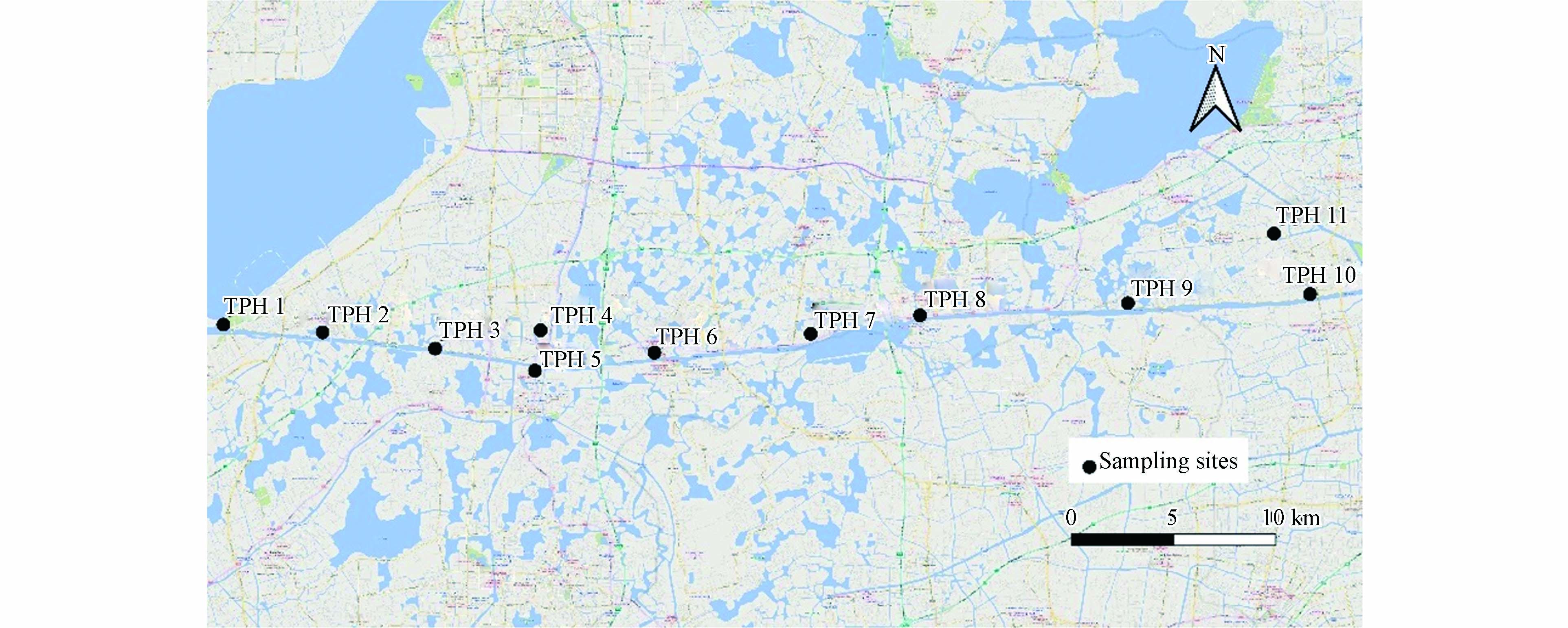
 下载:
下载:

